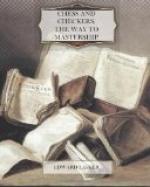His move would be in no way obstructed if some of his own or his adversary’s men were occupying the squares next to the one on which he stands. This enables the Knight as the only one of the pieces to move at the beginning of the game before any Pawn move has been made.
The strength of the Knight is ordinarily regarded as about equal to that of the Bishop. The latter’s range is larger but the Knight has the advantage of being able to reach any square of the board regardless of color.
The Pawn
It remains to describe the move of the Pawn, the only man who captures in a different way from that in which he moves. The Pawn moves forward only in the file in which he stands, and only one square at a time with the exception of his first move on which he may advance two squares. Thus, in Diagram 2, the white Pawn may move only to h5 while the black Pawn may move to either g6 or g5.
The Pawn may capture only diagonally, only forward and only one square at a time. The privilege of taking a double step on the first move does not extend to the capture. Thus in Diagram 2, the white Pawn could capture only a black man on g5, the black Pawn only a man on either f6 or h6, but not on e5. If a man stood on h5, the Pawn h4 would be blocked. Likewise would the Pawn on g7 be blocked by a man on g6.
There is one peculiar rule to be remembered in connection with the move of the Pawn. If a Pawn uses his privilege of making a double step to avoid capture by a hostile Pawn he can be put back one square and captured just the same. For instance, in Diagram 2, if the white Pawn stood on h5 and Black moved his Pawn to g5, White could put Black’s Pawn back to g6 and capture him with his Pawn. This way of capturing is called taking “en passant” (French for “in passing”) and can be done only by a Pawn, never by a piece.
Lastly must be mentioned the power of the Pawn to become transformed into a piece. This is done automatically whenever a Pawn reaches the extreme opposite side of the board. That is, the player must remove the Pawn from the board and put any piece on his place except a King. Thus it can happen that a player may play with three or more Rooks, Bishops, Knights or Queens. As the Queen is the strongest Piece the Pawns are practically always exchanged for Queens and for this reason the process of the exchange is called “queening.”
Although a Pawn has comparatively little value as measured by his mobility—his range of movement—he is really a very valuable man because of the possibility of his eventually queening.
Castling
Only once in a game is a player allowed to move more than one piece at a time. This one move is called “castling” and is made by the King together with one of the Rooks. In castling the King moves two squares toward the Rook and the Rook is placed on the square over which the King has passed. In the position of Diagram 3 both players may castle either side.




